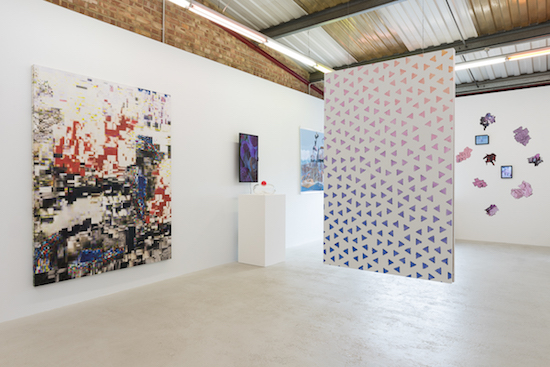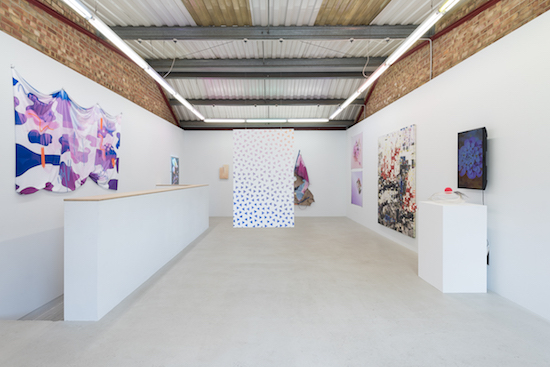The instantly recognisable thin white cabling of an Apple-branded USB charger snakes in and out of the works on display at Annka Kultys’s Bethnal Green gallery. In Signe Pierce’s backlit film image Electrotrash(2016), we see them trampled into the gutter, curling round broken CDs, dead flowers, and garishly iced ring donuts. In Swedish photographer Arvida Byström’s glossy print, What happens in may stays in may1(2015), they are wrapped around a posey of pink roses. In each case, the suggestion is of some impossible interface between the organic and the virtual, the street and the screen, as if energies and information could feed direct from one to the other.
Byström describes her work as “a discussion about nature and what is natural. We pick and choose what we see as natural or not,” she says. “And to me it’s just the same thing. Everything exists here, and either it’s natural, because everything stems from nature – or, it’s not.” The distinction, she implies, is arbitrary. There’s no way of drawing a line that isn’t in some way problematic. “It’s like, is nature when humans haven’t affected something? That doesn’t exist.”
The present exhibition, Zero Zero, was co-curated by Bystrom with digital artist Molly Soda and gallerist Ada Rajkovic, Alongside works by Byström, Soda, and Rajkovic themselves, it also features films and sculptures by Ivana Basic, a video by Maisie Cousins, a glass sculpture by Lucie Hardcastle, a textile work by Eric Mack, and a colour print by Cao Fei from her RMB City series, among other works.
The title, Rajkovic suggests, means “cloudy or indistinct, unable to see very well. All the artists,” she says, “are representing different versions of physical space mixed with virtual space.” Represented as figures, we could see the two 0s of Zero Zero as a pair of eyes staring blankly ahead. But equally we can see how Zero Zero could be opposed to the Zero and One of digital information, suggesting a new utopian form of data encoding that would move beyond the binaries of the net’s Cold War origins. Alternatively, as Byström suggests, Zero Zero could stand for a kind of radical negation, a not not or neither nor. Those twin 0s, she says, might not be sitting harmoniously side by side. They “might be negating each other.”

For a music fan, the first thing that comes to mind when confronted with the hi tech digital gloss, femme sports casual wear, and all-over pinkness of the show is the aesthetic that has become identified with the records and online presence around the label PC Music. Byström laughs an almost pantomime laugh when I mention this. “They came after us!” she bursts out. For a moment I think I’ve said the wrong thing. A nerve has been struck.
“I mean, I love their stuff,” she admits as she calms down. “They’re cool and all. But there’s definitely a certain layer of them being men and they’re extra cool because they’re hiding behind a female aesthetic – and it’s fine for guys to be able to use that aesthetic. But there’s something in that about how they use femininity because they can go in and out of that. Where women can’t just go in and out of that. And the Tumblr aesthetics that, I think, especially me and Molly have grown up in, on Tumblr – like, PC Music is way after that.”
Molly Soda and Arvida Byström go back a long way. But when I ask them how long, they both burst out laughing again.
“Um, known?” Soda raises an eyebrow.
“Like, offline? Or online?” Byström asks.
“We’ve known each other online for a really long time,” Soda confirms. “Like, 2012, 2011…”
Back then Soda and Byström were just two members of a whole swathe of young artists and image-makers re-blogging each other on Tumblr and using Instagram as their own personal instant gallery space. Since then, Byström has gone from photographing svelte young trans men and women to shoots with Pamela Anderson and Calvin Klein. Soda’s projects, from videos and gifs to zines and online performances projects, exploring the culture of young girlhood and online confessionals, has seen her attract the attention of Rolling Stone, MTV, and the Canadian singer-songwriter, Grimes.
Rajkovic, meanwhile, was turning her LA home into an art gallery.

A CalArts graduate with a degree in photography, Rajkovic found herself at the centre of a vibrant network of artists and musicians – in Hollywood and online. Announced by a bright pink neon sign, up a flight of stairs on a nondescript street, Sunday became the name of her live-work-exhibition space, one of the West Coast’s most well-concealed and most-talked-about artist project spaces. With a focus on art and artists marginalised by the white male-white cube axis of the mainstream gallery world, Instagram’s ‘Explore’ function became a portal into another world of online creativity. Soda and Byström were both early exhibitors at Sunday.
This is the first time the three of them have curated a show together, but far from the first time they’ve worked together. “Like, I did a show in Austin, and she did all the lights for that,” Soda says of Rajokvic, “and Arvida had a piece in it.” The more they talk, the more the tangled web of links and cross-references grow. “Everyone,” as Rajkovic puts it, “is so interconnected.”
So it’s kind of a scene then? I suggest.
“Oh, definitely,” Rajkovic says.
“But I feel like you come from, like, an off-line perspective on this,” Byström says to Rajkovic.
“Oh yeah,” Rajkovic agrees. “I was kind of the physical space and you guys were the online presence. I learned about so many artists off the internet. Everyone was just putting themselves out there so much. But I feel like it actually translates physically.”
“Yeah,” Soda says, “it does.”
“So that,” Rajkovic sums up, “is literally why we’re here.” You can almost hear the twinned asterisks either side of the word ‘literally’ as she says it.
Zero Zero is at Annka Kultys Gallery until 30 July


